Table of Contents
In today’s world of ever-increasing data demands and complex system requirements, scalability and performance are critical. Command Query Responsibility Segregation (CQRS) has emerged as a transformative architectural pattern to meet these challenges. By separating the read and write operations, It offers unparalleled flexibility, performance optimization, and maintainability.
In this article, we’ll explore the intricacies of CQRS, dive deep into event sourcing, showcase practical examples, discuss workload design, and examine implementation challenges.
Whether you’re an architect, developer, or tech enthusiast, this guide will provide actionable insights into why and when CQRS is the right choice for your system.
What is CQRS?
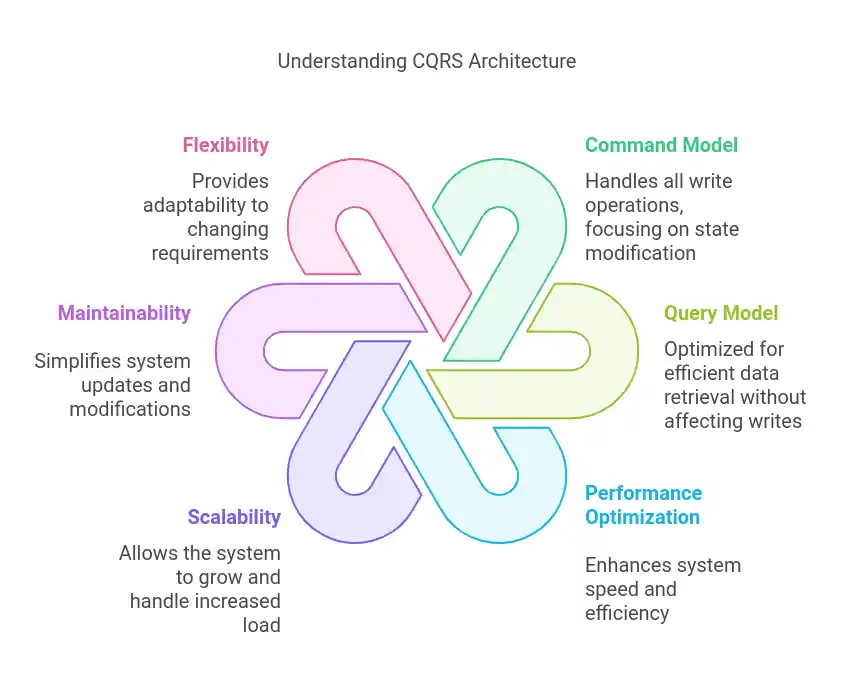
At its core, CQRS divides the responsibilities of a system into two parts:
- Command Model: Handles all write operations (e.g., creating, updating, deleting data). This model focuses on modifying the system’s state.
- Query Model: Handles all read operations, optimized for retrieving data efficiently without affecting the write side.
This separation ensures that each model can be designed and optimized independently, allowing developers to address different concerns in isolation.
CQRS is often used in conjunction with event sourcing, where state changes are captured as a sequence of events rather than directly modifying a database record. Together, these patterns enable a powerful and flexible architecture for complex systems.
Why Divide Reads and Writes?
In traditional architectures, a single database serves both read and write operations. This leads to trade-offs:
- Complex queries may degrade performance.
- Optimizing for writes often sacrifices read performance, and vice versa.
CQRS eliminates this conflict by dedicating resources and design strategies to each operation independently.
How Command Query Responsibility Segregation Works
To understand CQRS better, let’s break it down into its main components and processes:
1. Command Model
The command model focuses exclusively on processing commands. Commands are requests from the user or system to perform an action that changes the state. Examples include:
- “AddProductToCart”
- “PlaceOrder”
- “UpdateCustomerAddress”
Commands are validated against business rules before the changes are persisted to the database. The command model often uses:
- Aggregates: Objects that encapsulate business logic and ensure data consistency.
- Domain Events: Represent significant changes in the system, such as “OrderPlaced” or “ItemShipped.”
2. Query Model
The query model is optimized for reading data. It uses tailored views or projections that aggregate data in ways that make retrieval faster and more efficient. For example:
- A dashboard that displays total sales and order counts.
- A customer profile page that fetches orders, addresses, and payment methods.
The query model often involves denormalized or pre-aggregated data to minimize the number of queries and joins needed.
3. Synchronization Between Models
The separation of read and write models introduces the need for synchronization. This is typically achieved through event-driven communication. When a command is executed, domain events are published to inform the read model of changes. Event handlers then update the read model database to reflect the new state. This approach ensures eventual consistency between the two models.
Event Sourcing and CQRS Pattern
Event sourcing complements CQRS by introducing a new way of handling data. Instead of storing the current state, event sourcing captures state changes as a series of events.
How Event Sourcing Works:
- Actions (e.g., “PlaceOrder”) are recorded as immutable events (e.g., “OrderPlaced”).
- The application state is reconstructed by replaying these events.
- The query model listens to these events to update read-specific databases or views.
Advantages of Event Sourcing:
- Complete Audit Trail: Every change is logged, enabling thorough debugging and compliance with regulations.
- Replayability: System states can be recreated at any point in history by replaying events.
- Decoupling: Events act as the single source of truth, reducing dependencies between systems.
However, event sourcing introduces complexities like event versioning and ensuring idempotency in event handlers.ent sourcing introduces additional complexity, such as event versioning and ensuring that event handlers remain idempotent.
Example
Let’s explore a practical example of CQRS in an e-commerce platform:
- Command Model: Handles actions like “AddToCart”, “PlaceOrder”, or “CancelOrder.” Commands validate user input and apply business logic before updating the database.
- Query Model: Retrieves data for features like product search, order history, or inventory lookup. Pre-aggregated or denormalized views ensure high-performance reads.
- Event Synchronization: When an order is placed, events like “OrderCreated” and “InventoryUpdated” are emitted. These events update the query model and notify other systems.
For instance, a customer browsing an e-commerce site might see real-time inventory updates thanks to the efficient synchronization of the command and query models.
Workload Design
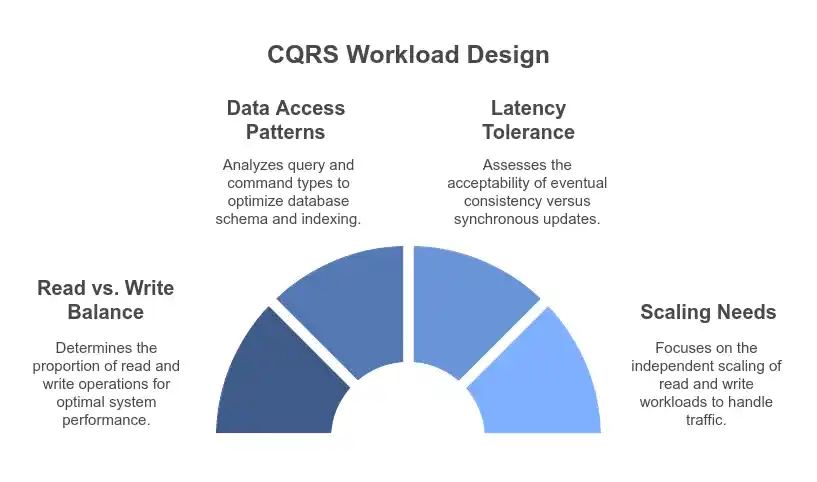
Designing workloads in a CQRS system requires careful consideration of:
- Read vs. Write Balance: Determine the proportion of read and write operations. Systems with high read demands benefit greatly from CQRS.
- Data Access Patterns: Analyze the types of queries and commands to optimize the database schema and indexing strategies.
- Latency Tolerance: Decide whether eventual consistency is acceptable. For critical operations, synchronous updates may be required.
- Scaling Needs: Independently scale read and write workloads. For example, you can replicate the query database to handle high read traffic while keeping the command database optimized for transactions.
When to Use Command Query Responsibility Segregation Pattern
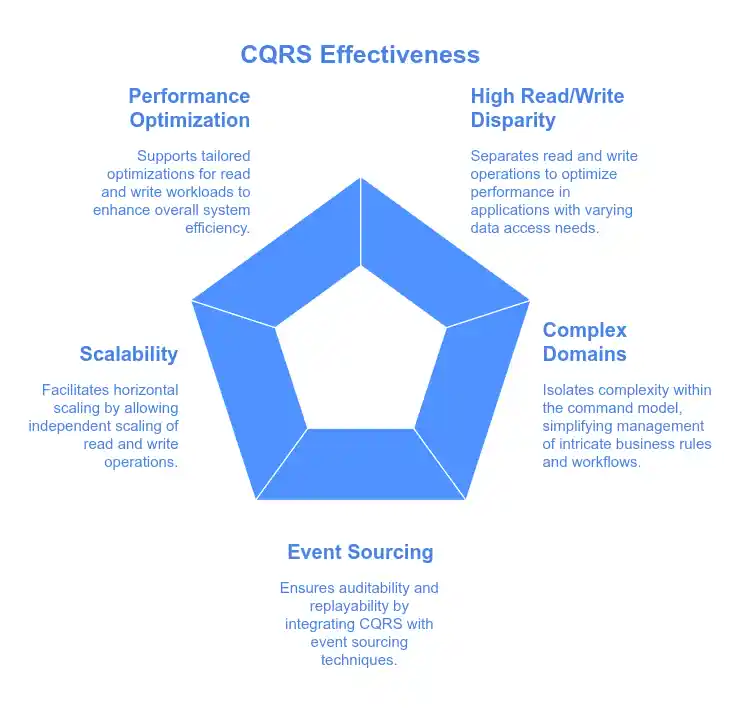
CQRS is most effective in scenarios with:
- High Read/Write Disparity: Applications like e-commerce or social media platforms benefit from separating read and write operations.
- Complex Domains: Systems with intricate business rules and workflows can isolate complexity in the command model.
- Event Sourcing Requirements: When auditability and replayability are essential, CQRS paired with event sourcing is a strong choice.
- Scalability Demands: For applications needing horizontal scaling, CQRS allows independent scaling of read and write operations.
- Performance Optimization: CQRS supports tailored optimizations for read and write workloads.
Implementation Issues and Considerations
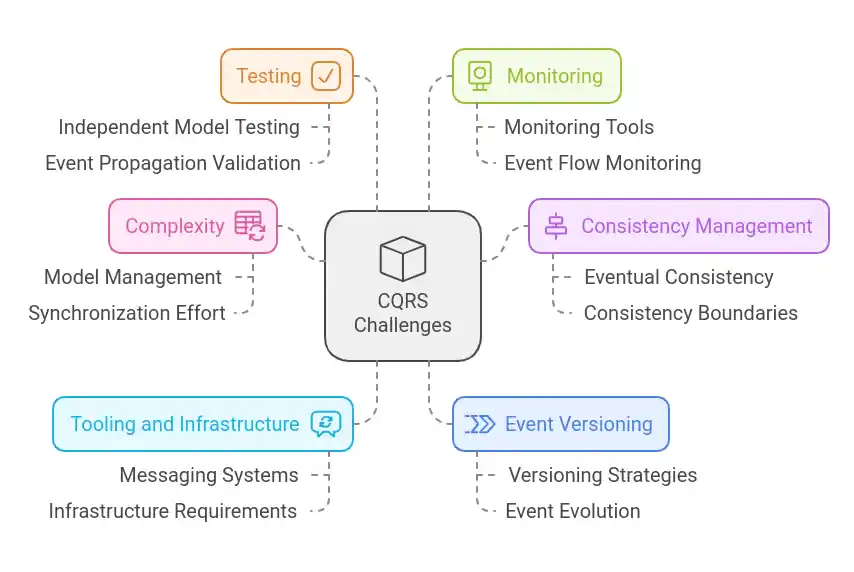
While CQRS offers numerous benefits, implementing it comes with challenges:
- Complexity: Managing separate models and synchronizing them requires additional effort.
- Consistency Management: Eventual consistency may not be suitable for all applications. Carefully design consistency boundaries.
- Tooling and Infrastructure: Implementing CQRS often requires robust messaging systems like Kafka, RabbitMQ, or Azure Service Bus.
- Event Versioning: Over time, events may evolve. Proper versioning strategies are necessary to maintain backward compatibility.
- Testing: Testing CQRS systems involves validating both models independently and ensuring event propagation works as expected.
- Monitoring: Use tools like Grafana, Kibana, or custom dashboards to monitor event flows and detect issues early.
7 Powerful Benefits of CQRS
The CQRS pattern provides numerous advantages that make it attractive for modern software systems:
1. Performance Optimization
- Independent Scaling: Since the read and write models are separate, each can be scaled independently to meet specific performance requirements. For instance, a system with high read demand can allocate more resources to the query side.
- Optimized Queries: The read model can be tailored for specific query patterns, using techniques like caching, pre-aggregation, or even different database technologies (e.g., NoSQL for reads, SQL for writes).
2. Improved Scalability
- CQRS allows horizontal scaling by distributing read and write workloads across multiple servers.
- Complex queries can be offloaded to the query model, reducing the load on the transactional database.
3. Enhanced Maintainability
- Clear separation of concerns simplifies the codebase. Developers can focus on specific aspects of the system without being overwhelmed by its entirety.
- Teams can work independently on the command and query sides, reducing development bottlenecks.
4. Flexibility
- Different technologies or schemas can be used for the command and query models. For example, a relational database might be used for commands while a graph database serves the queries.
- The architecture naturally supports microservices, where different services handle specific commands and queries.
5. Event-Driven Architecture
- CQRS pairs well with event sourcing, creating a robust and traceable system. Every state change is recorded as an event, providing a complete audit trail and enabling features like debugging, analytics, and replaying events.
6. Better User Experience
- By optimizing the query model for fast reads, users experience quicker response times for data retrieval.
Drawbacks of CQRS
Despite its benefits, CQRS is not a silver bullet. It introduces challenges and trade-offs that should be carefully considered:
1. Increased Complexity
- CQRS requires managing two separate models and ensuring proper synchronization between them.
- Event-driven communication can be challenging to implement and debug.
2. Eventual Consistency
- The read model may lag behind the write model, leading to temporary inconsistencies. While this is acceptable in many scenarios, some applications require strong consistency.
3. Higher Development Costs
- Designing and implementing CQRS takes more time and effort compared to simpler architectures.
- Teams need expertise in event-driven systems and distributed architecture.
4. Debugging and Monitoring Challenges
- Diagnosing issues in a CQRS-based system can be complex, especially when events fail to propagate correctly.
- Additional monitoring tools are often required to ensure synchronization and consistency.
Use Cases for CQRS
CQRS is particularly well-suited for scenarios where:
1. High Read/Write Disparity
- Applications with far more read operations than writes, such as e-commerce platforms, benefit from CQRS. The query model can handle a high volume of read requests efficiently without affecting the write model.
2. Complex Domains
- Systems with intricate business rules and workflows can use CQRS to isolate the complexity within the command model, simplifying the read model.
3. Scalable Systems
- Applications requiring horizontal scalability, such as social media platforms or analytics systems, leverage CQRS for efficient scaling.
4. Event Sourcing Integration
- When used with event sourcing, CQRS enables a complete history of system changes, making it ideal for systems requiring auditing, debugging, or compliance.
5. Real-Time Systems
- Applications like stock trading platforms or multiplayer games, where fast reads and event-driven updates are crucial, benefit significantly from CQRS.
Implementation Considerations
To successfully implement CQRS, several factors need to be addressed:
1. Event Handling
- Use robust messaging frameworks like RabbitMQ, Kafka, or AWS SNS/SQS to propagate events between the command and query models.
- Design event handlers to process events reliably and update the read model efficiently.
2. Database Design
- Choose appropriate database technologies for the command and query sides. For example, use a normalized relational database for the command model and a denormalized NoSQL database for the query model.
3. Consistency Guarantees
- Clearly define consistency requirements for your application. For critical systems, consider hybrid approaches that use strong consistency for essential operations and eventual consistency for others.
4. Monitoring and Debugging
- Implement logging and monitoring tools to track events and ensure synchronization between models.
- Use tools like Grafana or Kibana to visualize system performance and identify bottlenecks.
5. Testing and Validation
- Test both models independently to ensure correctness.
- Use integration tests to verify event propagation and consistency across the system.
CQRS in Practice
Example: E-Commerce Platform
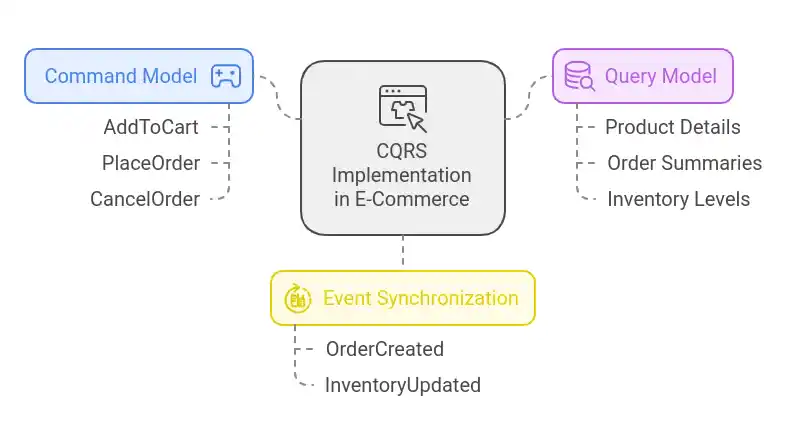
An online store typically has a high read-to-write ratio. Customers frequently browse product catalogs, view orders, and check inventory, but fewer write operations occur, such as placing orders or updating profiles. CQRS can be implemented as follows:
- Command Model: Handles actions like “AddToCart”, “PlaceOrder”, or “CancelOrder”. Commands update the inventory and order database.
- Query Model: Provides pre-aggregated views of product details, order summaries, and inventory levels for faster retrieval.
- Event Synchronization: When an order is placed, events like “OrderCreated” and “InventoryUpdated” update the query model.
Conclusion
CQRS is a powerful architectural pattern that brings significant benefits in scalability, performance, and maintainability. By separating the command and query responsibilities, systems can be tailored to meet specific operational demands. However, it’s crucial to assess the trade-offs and ensure that the complexity of CQRS aligns with the project’s needs.
For teams tackling large-scale, high-performance applications, CQRS can be an invaluable tool in the software architect’s toolkit. By carefully evaluating the requirements and constraints of a project, developers can leverage CQRS to build robust, efficient, and scalable systems that stand the test of time.
READ MORE:
Mastering Mobile Responsiveness: Building Websites That Stunning on Any Device
Effective AI in Hospitals: Reducing Burnout and Maximizing Efficiency